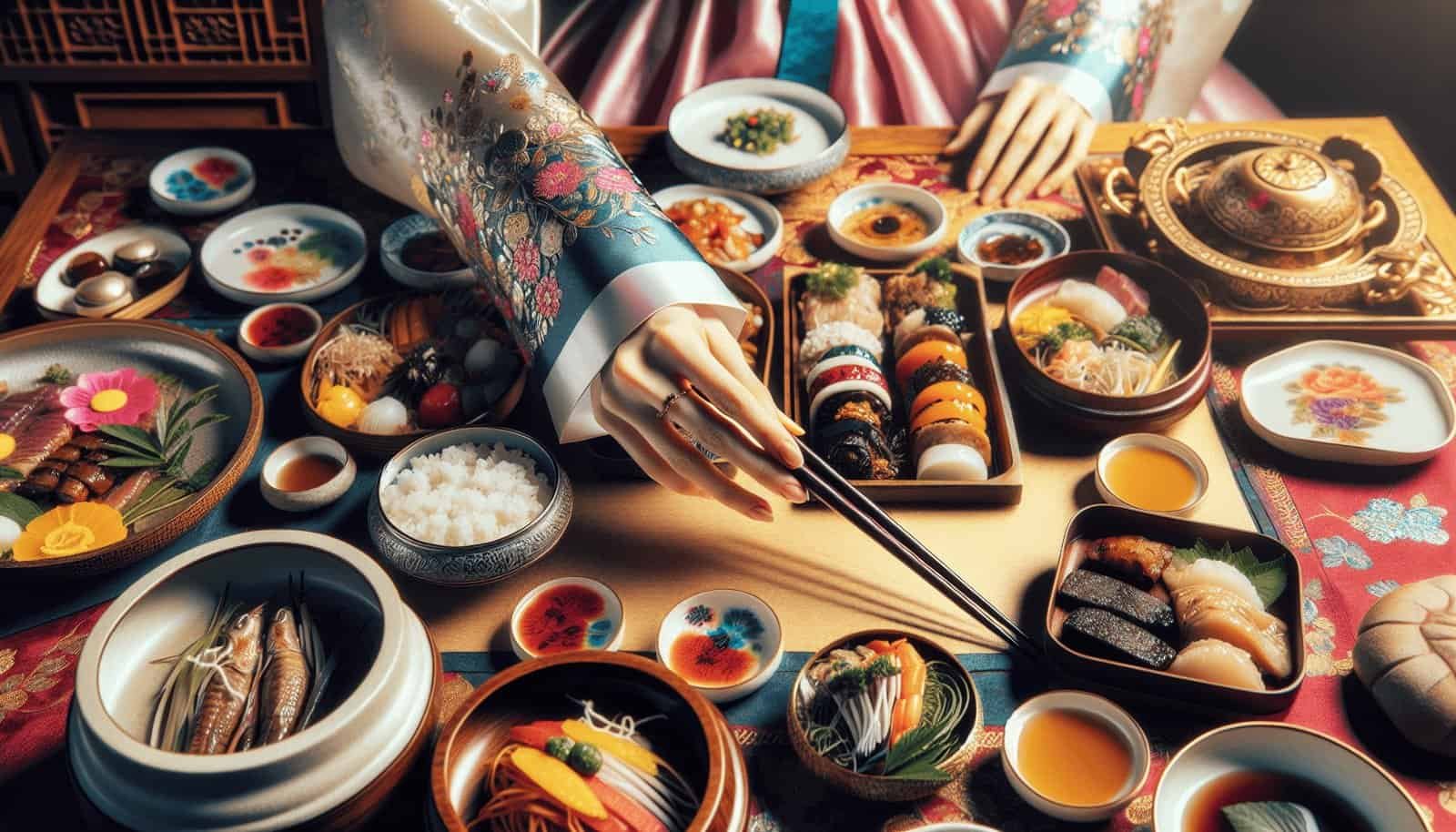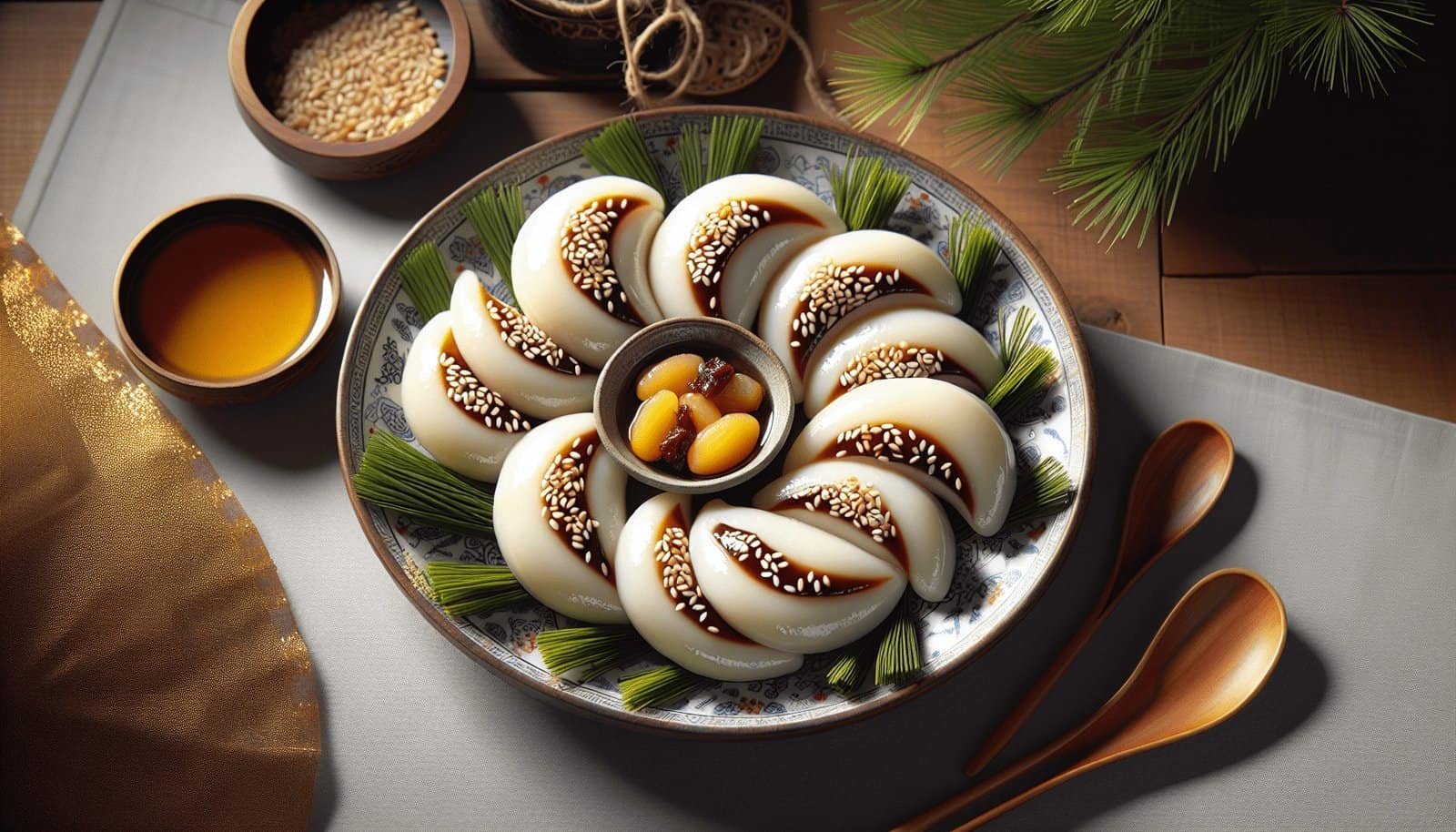Have you ever wondered about the cultural significance behind traditional Korean holiday dishes? From the spicy and savory flavors of kimchi to the comforting warmth of tteokguk, these dishes play a vital role in Korean celebrations. Each dish carries its own symbolism, representing prosperity, good luck, and ancestral spirits. By understanding the deeper cultural meanings behind these holiday dishes, you can truly appreciate the rich heritage and traditions of Korean cuisine. So, let’s explore the fascinating tales behind these mouthwatering delicacies!

Importance of Traditional Korean Holiday Dishes
Preservation of Cultural Heritage
Traditional Korean holiday dishes play a crucial role in preserving the country’s rich cultural heritage. These dishes have been passed down through generations, and each carries a unique history, significance, and preparation method. By continuing to prepare and enjoy these dishes during special occasions, Koreans keep their cultural traditions alive and ensure that future generations are connected to their roots.
Promotion of Family Unity
In Korean culture, holidays are truly cherished as a time for family gatherings and unity. Traditional holiday dishes act as a glue that brings family members closer together. The preparation and sharing of these dishes involve the whole family, creating opportunities for bonding, cooperation, and shared experiences. From grandparents passing down secret recipes to grandchildren eagerly learning traditional cooking techniques, these dishes foster a sense of interconnectedness and strengthen family ties.
Symbolism and Superstitions
Traditional Korean holiday dishes are filled with symbolism and superstitions that add depth and meaning to the celebrations. Many dishes are crafted to represent prosperity, good luck, longevity, and happiness. Koreans believe that consuming these symbolic foods during holidays will bring these positive qualities into their lives. Additionally, there are specific customs and taboos associated with certain foods, such as not cutting noodles to avoid cutting off blessings or refraining from eating all the rice cake soup on New Year’s Day to ensure a long life.
Types of Traditional Korean Holiday Dishes
Rice Dishes
Rice is a staple in Korean cuisine, and it holds special significance during holiday celebrations. Glutinous rice, in particular, is used in various holiday dishes, symbolizing unity and good luck. One notable rice dish is “songpyeon,” which is made with rice flour and filled with ingredients like sesame seeds, honey, or red bean paste. These small, crescent-shaped rice cakes are steamed on a bed of pine needles, giving them a distinct flavor and aroma.
Vegetable Side Dishes
Korean holiday tables are adorned with a variety of vegetable side dishes, known as “banchan.” These colorful and flavorful dishes are made from an array of ingredients such as spinach, mushrooms, radish, and cucumbers. The abundance of vegetable dishes signifies an abundant harvest and good fortune. Each vegetable side dish showcases Korean culinary techniques, including pickling, fermenting, and braising, resulting in a wide range of flavors and textures.
Meat and Fish Dishes
Meat and fish play an important role in traditional Korean holiday dishes. Grilled or braised beef dishes like “galbijjim” symbolize wealth and prosperity, making them a must-have on celebratory occasions. Fish dishes, such as steamed or grilled mackerel, are also popular during holidays due to their association with abundance and a bountiful marine harvest.
Soup and Stew
Soups and stews are essential components of traditional Korean holiday meals. These dishes not only provide nourishment but also embody cultural values. “Tteokguk,” a rice cake soup, is a staple during Seollal, the Lunar New Year. It represents a fresh start and the hope for a prosperous year ahead. Other soups and stews, like “kimchi jjigae” (kimchi stew) or “jjamppong” (spicy seafood noodle soup), add depth and variety to the holiday table.
Fermented Foods
Fermented foods hold a special place in Korean cuisine as they are deeply rooted in the country’s history and are believed to have numerous health benefits. During holidays, fermented foods like kimchi, soybean paste, and fermented shrimp are served as side dishes. These foods not only provide a unique flavor but also aid digestion and boost the immune system. Including fermented foods on the holiday table showcases the importance of maintaining good health and well-being.

Chuseok: Celebrating Harvest and Ancestry
Songpyeon
During Chuseok, the Korean harvest festival, “songpyeon” takes center stage. These small, crescent-shaped rice cakes are made with glutinous rice flour and filled with various ingredients such as sesame seeds, honey, or red bean paste. The unique feature of songpyeon is that they are steamed on a bed of pine needles, giving them a distinctive flavor and aroma. Symbolizing the abundance of the harvest, songpyeon serves as a delicious reminder of the country’s agricultural roots.
Galbijjim
Galbijjim is a braised beef dish that holds great significance during Chuseok. The dish consists of beef short ribs cooked in a flavorful marinade of soy sauce, garlic, ginger, and sweeteners like honey or sugar. Galbijjim symbolizes wealth, as beef was historically considered a luxurious ingredient only enjoyed by the wealthy. By having galbijjim on the Chuseok table, Koreans express their gratitude for a bountiful harvest and celebrate their increasing prosperity.
Japchae
Japchae, a stir-fried noodle dish, is a must-have during Chuseok. Made with sweet potato glass noodles, assorted vegetables, and seasoned with soy sauce and sesame oil, japchae embodies the vibrant colors and flavors of autumn. The inclusion of various vegetables signifies the abundance of the harvest, while the long, uncut noodles symbolize longevity and uninterrupted fortune. Japchae’s delightful taste and festive symbolism make it a favorite dish during Chuseok.
Seollal: Welcoming the Lunar New Year
Tteokguk
Tteokguk, a traditional rice cake soup, takes center stage during Seollal, the Korean Lunar New Year. The soup is made with sliced rice cakes simmered in a flavorful broth, along with thinly sliced beef, vegetables, and sometimes a sprinkle of egg garnish. Tteokguk holds deep symbolism, representing a fresh start and the hope for a prosperous year ahead. In Korean tradition, eating a bowl of tteokguk on New Year’s Day adds another year to your age and brings good luck and fortune.
Jeon
Jeon, a type of Korean pancake, is a beloved dish during Seollal celebrations. Common ingredients used to make jeon include vegetables, meat, or seafood. The pancake batter is made with a mixture of flour, eggs, and water, resulting in a crispy yet chewy texture. Jeon is not only a delicious treat but also holds cultural significance, representing the circle of life and the passing of another year. Sharing jeon with family and friends during Seollal symbolizes unity and a fresh start.
Yakgwa
Yakgwa, a traditional Korean sweet pastry, is often enjoyed during Seollal. The pastry is made by deep-frying wheat-based dough and then coating it with a syrup made from honey, ginger, and sesame oil. Yakgwa’s sweet and fragrant taste adds a festive touch to the Lunar New Year celebrations. This delicacy is not only a delicious treat but also represents good luck, as the shape of the pastry resembles delicate flowers.

Dano: Honoring Ancestors and Nature
Ssambap
Ssambap is a traditional dish enjoyed during Dano, a holiday that honors ancestors and nature. The dish consists of freshly steamed rice served with various leafy greens, such as lettuce or perilla leaves. The diners take a leaf, place rice and different side dishes in the center, and then wrap it into a bundle. Ssambap’s preparation and consumption embody harmony with nature, as the greens are often sourced locally and represent the essence of the season.
Woojeon
Woojeon, a type of Korean pancake, is a popular dish during Dano. It is made by pan-frying a batter composed of various herbs and greens, such as chrysanthemum leaves, bellflower roots, or fernbrake. Woojeon’s springtime flavors and vibrant colors celebrate the arrival of warmer weather and the rebirth of nature. By incorporating fresh and seasonal ingredients, woojeon pays homage to the beauty and abundance of the natural world during Dano.
Surichwi
Surichwi, also known as Oxalis tuberosa, is a root vegetable commonly enjoyed during Dano. This nutritious and tangy vegetable is often pickled or added to soups and stews, enhancing the flavor and adding a hint of acidity. Surichwi is believed to possess medicinal properties and is said to promote digestion and detoxification. Its inclusion in Dano dishes signifies a celebration of health and gratitude for the offerings of nature.
Gimbap: A Versatile Korean Dish
Gimbap’s Influence
Gimbap, a popular Korean dish, has become an essential part of many Korean holiday feasts. Similar to sushi, gimbap consists of rice, seasoned vegetables, and sometimes meat or seafood, rolled into a sheet of seaweed. The dish holds cultural significance as it was introduced to Korea during Japanese occupation, but it has since become a unique part of Korean cuisine. Gimbap’s versatility and adaptability have made it a beloved dish enjoyed by Koreans during various festive occasions.
Nutritional Benefits
Gimbap not only delights the taste buds but also offers numerous nutritional benefits. The combination of rice and vegetables in gimbap provides a balanced mix of carbohydrates, proteins, and vitamins. The seaweed used to wrap gimbap is rich in minerals like iodine, calcium, and iron. Additionally, gimbap is a portable and convenient dish, making it a perfect choice for picnics or family gatherings during holidays.
Symbolism in Gimbap
Gimbap holds symbolic meanings in Korean culture. The dish’s cylindrical shape represents unity and completeness, reminding Koreans of the importance of harmony and togetherness during festive occasions. The variety of colorful fillings, such as yellow pickled radish, green spinach, and red carrots, symbolize the vibrant hues of life and the blessings of abundance. Sharing and enjoying gimbap with loved ones reinforces the values of sharing, unity, and family bonds.

Kimchi: A Staple of Korean Cuisine
Kimchi’s Historical Significance
Kimchi has a long and storied history in Korean cuisine, dating back centuries. Originally, kimchi was a way to preserve vegetables during harsh winters. Over time, it evolved into an iconic dish that is deeply ingrained in Korean culture. Each region and family in Korea have their own unique kimchi recipes, resulting in an incredible range of flavors and variations throughout the country.
Cultural Importance
Kimchi holds immense cultural importance within Korean society. It is not just a side dish but a fundamental part of daily meals and celebratory feasts. Koreans believe that the spicy and tangy flavors of kimchi stimulate the appetite, aid digestion, and boost the immune system. Moreover, kimchi-making has been recognized as an Intangible Cultural Heritage by UNESCO, highlighting its significance as a tradition worth preserving.
Different Varieties of Kimchi
Kimchi comes in various forms, each with its exquisite taste and ingredients. The most well-known type is “baechu kimchi,” made from Napa cabbage. This variety is characterized by its spicy and slightly sour taste. Other popular types include radish kimchi, cucumber kimchi, and water kimchi. Each variety brings its own unique flavor profile to the table, ensuring a diverse and satisfying culinary experience.
Bibimbap: Harmony in a Bowl
Symbolic Elements
Bibimbap, which literally translates to “mixed rice,” is a beloved Korean dish that represents harmony and balance. It consists of a bowl of steamed rice topped with various seasoned vegetables, meat, and a fried egg, all arranged in colorful sections. Before eating, it is customary to mix all the ingredients together, blending the flavors and creating a harmonious blend. Bibimbap’s vibrant colors and the act of mixing symbolize the pursuit of balance and unity in all aspects of life.
Regional Variations
Bibimbap has numerous regional variations throughout Korea, each reflecting local preferences and ingredients. The most famous variety is “dolsot bibimbap,” which is served in a hot stone bowl. The bowl’s heat gives the rice a crispy texture and adds depth to the flavors. Another variation is “hoe bibimbap,” which features raw fish or seafood as the main ingredient. Regardless of the regional differences, bibimbap continues to be a beloved dish on special occasions, bringing people together through its harmonious blend of flavors.
Health Benefits
Bibimbap is not only a tasty dish but also a nutritious one. Bursting with fresh vegetables, it provides essential vitamins, minerals, and fiber. The inclusion of lean proteins, such as beef or tofu, adds a satisfying element to the dish. Additionally, bibimbap can be customized to dietary preferences, making it a versatile and healthy choice for everyone.

Japchae: A Noodle Dish for Celebrations
Japchae’s Origins
Japchae, a dish made with sweet potato glass noodles, has a fascinating history that dates back to the Joseon Dynasty. Originally created by royal chefs, japchae was served in the royal court as a luxurious dish. Over time, it made its way into the homes of commoners and has become a staple during festive celebrations and special events. Today, japchae is known for its delicate balance of flavors and a variety of colorful ingredients.
Ingredients and Preparation
Japchae features a rich array of ingredients, including sweet potato glass noodles, thinly sliced vegetables such as carrots, bell peppers, onions, and mushrooms, and sometimes marinated beef. The noodles are cooked until tender, and the vegetables are stir-fried to perfection. The dish is then seasoned with soy sauce, sesame oil, and various other seasonings, creating a delightful combination of umami flavors that make japchae a standout dish for celebrations.
Japchae for Special Occasions
Japchae is often served during celebratory occasions, such as birthdays, weddings, and holidays. Its association with joyous events makes it a welcome sight on the dining table. The colorful assortment of ingredients in japchae symbolizes good luck and fortune, while the long and uncut noodles are believed to bring long life and prosperity. Whether enjoyed as a side dish or a main course, japchae adds a touch of elegance and festivity to any special gathering.
Sujeonggwa: A Festive Korean Punch
Sujeonggwa’s Origins
Sujeonggwa, a traditional Korean punch, has a rich history dating back to the Joseon Dynasty. It was originally served in royal courts and noble households as a refreshing beverage during special occasions. Over time, it became a beloved drink enjoyed by all Koreans, particularly during festive holidays. Sujeonggwa is made with dried persimmons, cinnamon, ginger, and honey, creating a flavorful and aromatic punch that is both refreshing and invigorating.
Ingredients and Preparation
The key ingredient in sujeonggwa is dried persimmons, which are boiled with water, cinnamon, and ginger to extract their essence. The liquid is then sweetened with honey or sugar to achieve the desired level of sweetness. The result is a vibrant and fragrant punch with a unique blend of fruity, spicy, and sweet flavors. Sujeonggwa is typically served cold and garnished with pine nuts, adding a delightful crunch to each sip.
Traditions and Meaning
Sujeonggwa holds a special place in Korean holiday traditions, embodying the spirit of celebration and togetherness. The vibrant red color of the punch symbolizes good fortune and happiness, while the mixture of flavors represents the diverse joys and blessings of life. Serving sujeonggwa to guests during holidays is considered a gesture of hospitality and a way to spread joy and warmth. It is a drink that brings people together and makes every festive occasion more memorable.
